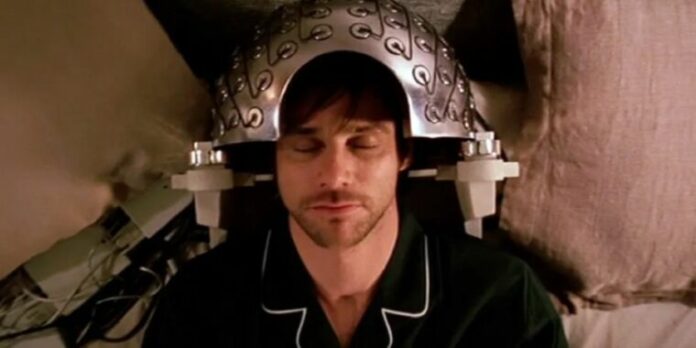Focus Features
Last week, the 2004 cult classic Eternal Sunshine of the Spotless Mind marked its 20th anniversary, prompting many people to revisit the surreal sci-fi psychological drama about two ex-lovers who erase their memories of each other—only to find themselves falling in love all over again. Eternal Sunshine was a box office success and earned almost universal praise upon its release. It’s still a critical favorite today and remains one of star Jim Carrey’s most powerful and emotionally resonant dramatic roles. What better time for a rewatch and in-depth discussion of the film’s themes of memory, personal identity, love, and loss?
(Spoilers for the 2004 film below.)
Director Michel Gondry and co-writer Pierre Bismuth first came up with the concept for the film in 1998, based on a conversation Bismuth had with a female friend who, when he asked, said she would absolutely erase her boyfriend from her memory if she could. They brought on Charlie Kaufman to write the script, and the three men went on to win an Oscar for Best Original Screenplay for their efforts. The title alludes to a 1717 poem by Alexander Pope, “Eloisa to Abelard,” based on the tragic love between medieval philosopher Peter Abelard and Héloïse d’Argenteuil and their differing perspectives on what happened between them when they exchanged letters later in life. These are the most relevant lines:
Of all affliction taught a lover yet,
‘Tis sure the hardest science to forget!
…
How happy is the blameless vestal’s lot!
The world forgetting, by the world forgot.
Eternal sunshine of the spotless mind!
Carrey plays Joel, a shy introvert who falls in love with the extroverted free spirit Clementine (Kate Winslet). The film opens with the couple estranged and Joel discovering that Clementine has erased all her memories of him, thanks to the proprietary technology of a company called Lacuna. Joel decides to do the same, and much of the film unfolds backward in time in a nonlinear narrative as Joel (while dreaming) relives his memories of their relationship in reverse. Those memories dissolve as he recalls each one, even though at one point, he changes his mind and tries unsuccessfully to stop the process.
The twist: Joel ends up meeting Clementine all over again on that beach in Montauk, and they are just as drawn to each other as before. When they learn—thanks to the machinations of a vengeful Lacuna employee—what happened between them the first time around, they almost separate again. But Joel convinces Clementine to take another chance, believing their relationship to be worth any future pain.

Much has been written over the last two decades about the scientific basis for the film, particularly the technology used to erase Joel’s and Clementine’s respective memories. The underlying neuroscience involves what’s known as memory reconsolidation. The brain is constantly processing memories, including associated emotions, both within the hippocampus and across the rest of the brain (system consolidation). Research into reconsolidation of memories emerged in the 2000s, in which past memories (usually traumatic ones) are recalled with the intent of altering them, since memories are unstable during the recall process. For example, in the case of severe PTSD, administering Beta blockers can decouple intense feelings of fear from traumatic memories while leaving those memories intact.
Like all good science fiction, Eternal Sunshine takes that grain of actual science and extends it in thought-provoking ways. In the film, so-called “problem memories” can be recalled individually while the patient is in a dream state and erased completely—uncomfortable feelings and all—as if they were computer files. Any neuroscientist will tell you this is not how memory works. What remains most interesting about Eternal Sunshine‘s premise is its thematic exploration of the persistence and vital importance of human memory.
So we thought it would be intriguing to mark the film’s 20th anniversary by exploring those ideas through the lens of philosophy with the guidance of Johns Hopkins University philosopher Jenann Ismael. Ismael specializes in probing questions of physics, metaphysics, cognition, and theory of mind. Her many publications include The Situated Self (2009), How Physics Makes Us Free (2016), and, most recently, Time: A Very Short Introduction (2021).


